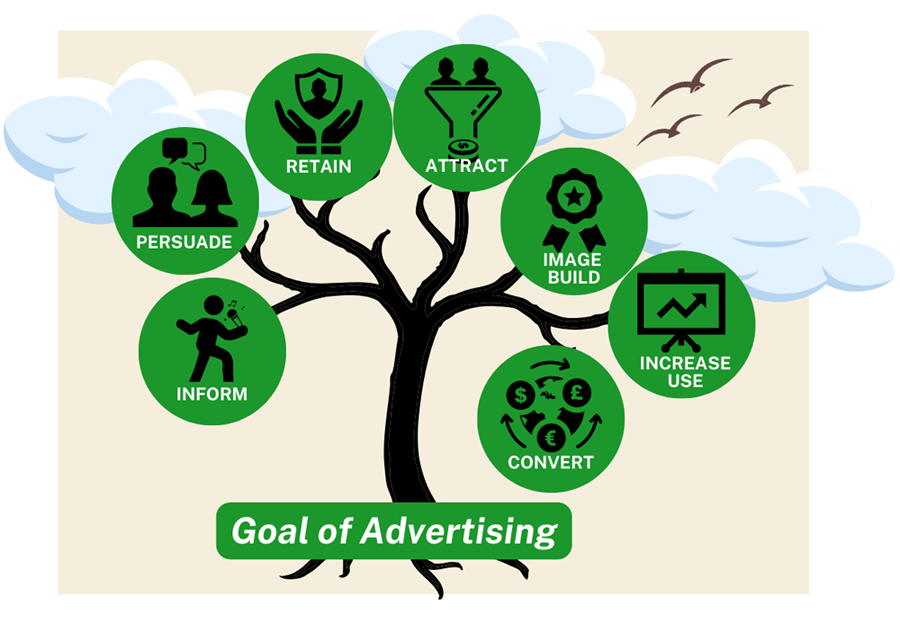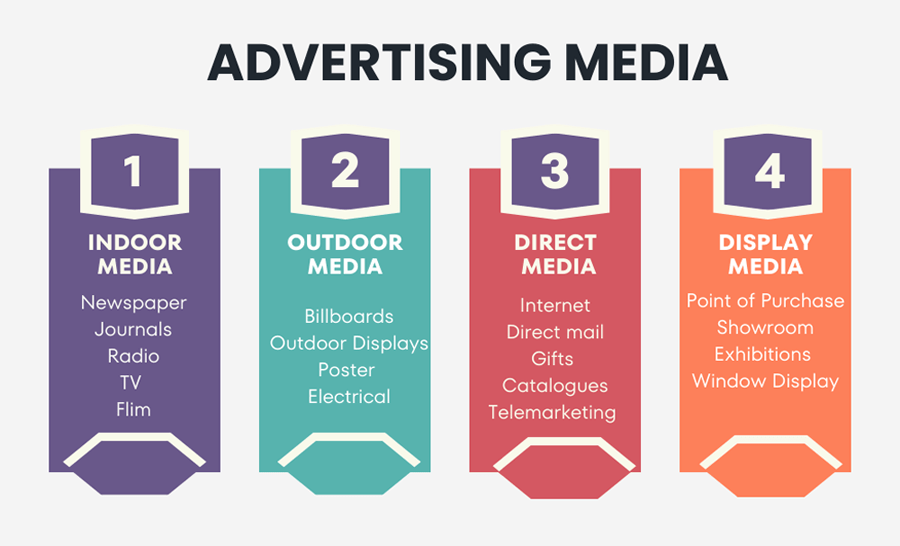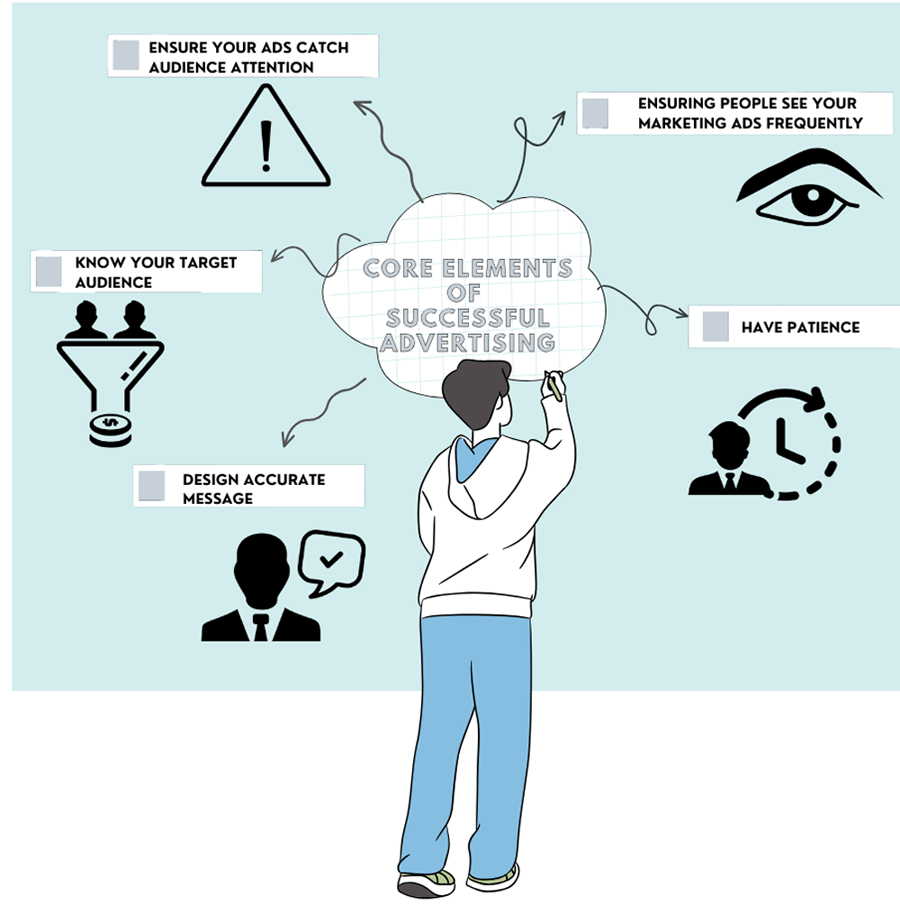Advertising

Stopping advertising to save money is like stopping your watch to save time.
Actually, advertising is the art of persuasion. It persuades the audience to become loyal to the brand and buy more products from the firm. Effective advertising always gives a higher return on investment to their respective firm.
Advertising is a paid, controlled type of communication from a known source that is intended to encourage the receiver to take some action now or in the future.
The majority of advertising is designed to persuade the viewer to take action. Ads may encourage consumers to try new things or to stick with companies they already know and trust. Some advertisements even attempt to persuade consumers to do less of something, such as use less water or energy.
Depending on their marketing strategy, businesses and organizations utilize a variety of advertising methods. The marketing strategy will decide who the advertising targets should be, where the advertising should appear, and what goals it should achieve. It can also specify what the audience is supposed to observe, think, and feel.
Goal of Advertising

Advertising goal setting is dependent on market conditions and the provider–product scenario. Sub-goals are frequently required as a way of achieving the goals.
Inform: Provide product information, including price, features, advantages, and service and product options.
Persuade: Marketing persuades target customers to make purchases of just the advertised brand.
Retain: Encourage need-satisfaction in order to resist change
Attract: Encourage desire for your product by helping customer envision how it can effectively meet their needs..
Image Build: Properly designed marketing creates a favorable image of your product in the minds of customers.
Increase use: Encourage desire growth by demonstrating other applications for the goods and services.
Convert: Promote need-focus by demonstrating how a product satisfies a customer’s needs better than competitors.
Key Players of Advertising

There are numerous parties involved in delivering messages from marketers to target customers. They’ve
Advertiser
Advertiser is the first step in the advertising process. Typically, it is the corporation that invests in advertising and makes important decisions about advertising such as target audience, message, medium, and budget.
Advertising Agency
It aids in the coordination of marketers and media. Few larger corporations have their own in-house advertising firm. Advertisers, on the other hand, hire specialist ad agencies that develop, produce, and position advertising in media on their behalf. Creative experience, efficiency, workforce talent, media understanding, and negotiating abilities are all assets of an ad agency.
Media
It is a communication channel that assists in communicating the advertiser’s message to the target audience. It changes according to how popular it is with the audience. If a media outlet has a better reputation and reaches among its target consumers, it may charge a greater cost to advertisers for the same amount of space as its competitors.
Venders
They are a service provider that assists marketers, ad agencies, and media in their daily operations. Photographers, photo/video editors, cameramen, printers, songwriters, designers, and market researchers are among them.
Target Audience
Advertising is designed to reach a certain audience. The effectiveness of advertising is entirely dependent on how the target audience sees it.
Evolution of Advertising
Advertising is not a novel concept. It has evolved in a dynamic manner. It began with the advent of trade. The market’s evolution has been largely affected by economic development and evolving customer desire.
Early Advertising
Craftspeople like potters and basket weavers could trade for food and goods. The invention of money made transactions easier and created a need to highlight commodities or services in the market, leading to advertising.
Shopkeepers initially placed carved signs in front of their stores to show what items were available. Since most people couldn’t read, signs often used symbols, like a boot for a cobbler. This era, called the preindustrial age, lasted from the start of civilization until the early nineteenth century in Western civilization.
During the preindustrial period, several key developments led to modern advertising. The Chinese developed paper, and Europe had its first paper mill by 1275. Johannes Gutenberg invented the printing press in Germany in the 1440s. This invention revolutionized advertising and communication, changing how people lived and worked.
This new technology enabled the creation of the first advertising formats – posters, handbills, and signs and eventually led to the first mass medium, the newspaper. This allowed vendors’ messages to reach far beyond their immediate surroundings.
The Industrial Age and the Birth of Agencies
The Industrial Revolution began in England in the late 1700s and spread to North America by the early 1800s. Large corporations used machines to mass-produce goods of uniform quality, making it cheaper to buy items than to make them. As people moved to cities for work, large urban markets formed, boosting market expansion and advertising growth.
Advances in transportation made it easier to distribute goods beyond local markets, sparking interest in mass marketing and advertising. Technological innovations during the Industrial Revolution led to significant advancements in advertising. The introduction of photography in 1839 brought realism and creativity to ads, allowing them to depict real images instead of illustrations.
In the 1840s, businesses began using magazine advertisements to reach a broader market and promote mass purchases. Magazines enabled nationwide advertising with high-quality reproduction. Public education raised the literacy rate to 90 percent, giving manufacturers access to a large audience that could read print ads. By the early 20th century, the U.S. had become an industrial power with a national marketing system driven by advertising. The modern era of advertising began after World War I.
At the same time, radio emerged as a major communication and advertising medium. It delivered live news and entertainment, reaching a wide audience. Brands used advertising to highlight their unique qualities, with producers promoting their products as distinct and superior through quality, variety, and convenience.
The Golden Age of Advertising
The golden period of advertising began after World War II (1945) and lasted until around 1979. Television, debuting in 1941, experienced the largest media expansion and quickly became the top advertising medium by revenue. Postwar affluence in the late 1940s and early 1950s led consumers to buy more sophisticated goods, marking the golden era of advertising. Ads focused on social approval, elegance, luxury, and success, leading to a creative revolution.
Rosser Reeves of the Ted Bates Agency suggested ads highlight the product’s unique selling proposition (USP), differentiating it from competitors. However, as more products promised similar qualities, the USP approach lost its impact. Manufacturers then shifted to market segmentation, targeting distinct groups with specialized products.
The Postindustrial Age
The post-industrial age began around 1980, marked by significant upheaval. People became aware of the environmental risks of consumerism and their reliance on natural resources. During the energy shortages of the 1970s and 1980s, the term “demarketing” emerged. Energy producers used advertising to reduce demand, urging people to avoid using appliances during peak hours.
Demarketing evolved into a strategy against competitors, political opponents, and social issues, such as campaigns to reduce cigarette use. Increased competition, driven by international trade, offered consumers more options, better quality, and lower costs. As the U.S. economy stagnated, businesses faced fewer consumer dollars and reduced advertising expenditures, turning to cost-effective methods like discounts, direct mail, and direct marketing. By 1990, advertising lost 25% of its marketing budget share to these alternatives.
In the 1990s, the traditional advertising sector faced overpopulation and competition from new media technologies, which failed to deliver long-term profitability for many firms. By the mid-1990s, American marketers began shifting resources back to advertising to recover brand value. Technology, changing lifestyles, security concerns, and the cost of reaching customers had irrevocably altered the industry. The growth of the Internet signaled a new technological frontier.
The Global Interactive Age: Looking at the Twenty-First Century
Global advertising expenditures outside the United States now exceed $400 billion annually. Ten emerging markets account for more than half of global media spending. Advertising expenditures are higher in nations with higher per capita incomes, and Eastern European countries now recognize the benefits of advertising despite previously denouncing it as a capitalist evil.
New technologies have significantly impacted advertising. In the late 1990s and early 2000s, cable turned TV from a mass medium to a specialized one. Fast Internet access has further transformed media consumption, with on-demand services like Netflix and YouTube leading to cable cutting. Digital technology, including tablets and smartphones, offers advertisers new channels to reach customers.
This shift has given rise to a new breed of advertising professionals skilled in coding and programming. Social media, a groundbreaking method for advertising, reaches nearly a billion people monthly on platforms like Facebook and YouTube. Marketers are shifting significant budget portions to engage users on these platforms.
The rise of new media has disrupted traditional ones, with the newspaper industry suffering significant declines in ad revenue. Advertising has evolved from simple signs to a powerful tool for shaping trends and describing value. Companies now recognize that their most valuable asset is their relationship with customers.
The new marketing objective for the twenty-first century is to protect this asset. Businesses must be consistent in their messaging and actions, integrating all marketing communications with their overall strategy. This approach, known as integrated marketing communications, presents new challenges and opportunities for marketing and advertising professionals.
Advertising Media

Advertising media is a vehicle or technology that conveys the advertiser’s message to the target customer. An advertiser has a variety of media options from which to convey his/her own advertising message.
Indoor Media: Newspaper, Journals, Radio, TV, Flim etc
Outdoor Media: Billboards, Outdoor Displays, Poster, Electrical etc
Direct Media: Internet, Direct mail, Gifts, Catalogues, Telemarketing etc
Display Media: Point of Purchase, Showroom, Exhibitions, Window/Shelf Display etc
Because there is no solid information, choosing advertising media is a challenging process. Advertisers rely on their own knowledge, judgment, demographics, and geographic location.
Companies may go back and forth between media due to changes in advertising material or to stress the quality of their products.
The importance of media coverage cannot be overstated because it speaks to the size of the audience. Recently, advertising firms have emphasized the media schedule, i.e., how to run advertisements in each media throughout the duration of the campaign. They also recommend that product promotion be based on research of ‘generic vs. selective demand.
Core Elements of Successful Advertising

Below are the elements that help to make a successful advertisement.
Design Accurate Message for Audience
A lot of advertising gives out a very mixed message to potential buyers. Advertising must be well-planned and straightforward. Sit down and take some time to consider the exact message you want to convey to potential consumers.
Advertising frequently becomes crowded and confusing as a result of having too much information in the advertisement or commercial. If you can’t sum up your point in one short statement, go back to the drawing board until you can.
Once you’ve discovered the key sentence, design your commercial to clearly convey this message. If you repeat one message rather than trying to add a variety of different messages, your advertising will produce considerably better results.
To make advertising work for any firm, you must first decide what message you want to send to potential consumers.
Know Your Target Audience
Knowing exactly who you want to view your advertisement is a critical component of campaign strategy. Most advertising sales agents will ask you this question.
The jargon for it is the ‘demographic’ you are attempting to target. This can contain information such as the potential customer’s age, gender, wealth level, and geographical area, to name a few components of a demographic breakdown.
The more specific you are about your intended audience, the more efficiently you can design your advertising. Whenever you are creating an advertising campaign, spend a little time thinking about who you want to view your commercials.
Ensure Your ADs Catch Audience Attention
The major reason that advertising does not work for many firms is that the advertisement or commercial fails to capture the attention of the targeted clients. Every day, audiences are overloaded with hundreds of commercial messages, no matter where they are. As a result, it is simple to see why it is critical that your advertisement stand out from the crowd.
Ensuring People See Your Marketing ADs Frequently
This is the most basic component of advertising—get as many people as possible to view your ad as often as possible, and your ad will provide far better results. To reach your target audiences, use a variety of media such as social media, television, email, radio, and print advertising.
Have Patience
It is quite unlikely that a potential consumer would view your advertisement once and then rush to pick up the phone or get in the car. It takes a number of viewings of advertising before customers are convinced that they require your product or service.
Advertisement Techniques

Copywriters apply a number of strategies to convey a message that is both effective and memorable. Because a straight headline and text would be mistaken with the editorial, publications now include the word ‘Advertisement’ above layouts of this style.
Unique Selling Point (USP)
Many advertisers’ first preference is to identify and isolate a unique selling proposition, i.e. an advantage that you alone possess. Improve and develop it so that it includes your core message and appeal. Many goods are made up of a variety of benefits, the majority of which are embodied in the competition. Analyzing and comparing them all might get boring, so why not focus on just one and enjoy.
Before and after
Illustrations demonstrating increased performance before and after therapy might be convincing. This method is useful for double glazing, paint treatments, lawn fertilizers, hair washes, chair coverings, and a variety of other facelifts. It may be extremely useful for services as opposed to goods.
Highlight Advantages
Often, seeing a product in motion is the greatest approach to sell its benefits. Nobody buys product features and attributes; consumers seek solutions to their problems. If a customer believes a product is excellent enough to meet their needs, they will purchase it.
Endorsements
A professional should be employed to market to technocrats, while housewives should be utilized to sell washing liquid. The stereotype still reigns supreme in the world of advertising.
Most businesses will have a ready file of endorsements on hand, but if none are just right, send out a questionnaire to customers asking for feedback, and you will almost certainly get something relevant. Apart from the fact that it is immoral, you should never have to invent them.
Comparisons
It is all about comparison when it comes to product choice. It is done by the consumer while selecting which goods to purchase. He considers the characteristics and benefits. However, until recently, competitive advertising – or ‘knocking’ copy – was deemed immoral.
Comparison advertising may be both lucrative and ethical if done correctly. Marketers should not state competitors by name like the auto industry does, but rather by inference.
Unique and Originality
Some unexpected characteristics depicted in the layout might draw attention to your message. It’s our first advertising attraction rule. Including advertisements in ways that no one else has done before. A man sewing or even cooking, for example, is worth a second look. Perfectly legitimate activities, but not in the sense that home tasks are typically depicted.
Usefulness to Users
Try to show the product in action, in a real-world setting. If you work with food, make sure that no hygiene standards are breached or that manufacturing workers are not violating Health and Safety rules.
Babies are a terrific attraction, especially if you’re trying to market to moms. There can’t be too many household items where a pretty baby photo isn’t used in the ad at some point. Animals are entitled to the same treatment as humans.
Humour
Marketing experts use humor to convince consumers to purchase a product, pay for a service, give to a cause, or be influenced in other ways. By making people laugh and feel good, the Humor Appeal persuades them to enjoy an organization, brand, product, service, or concept.